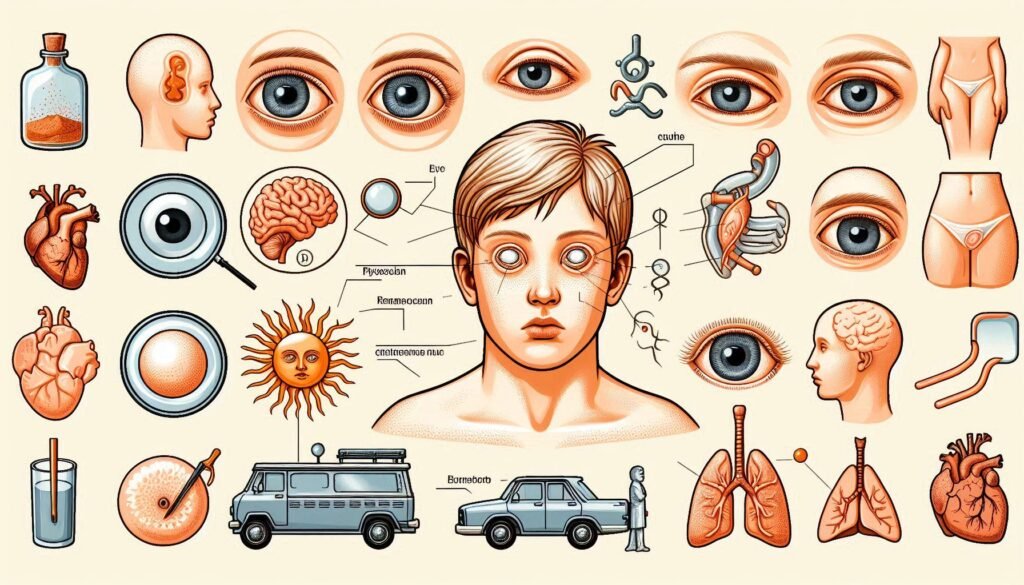Oculo-Auriculo-Vertebral Spectrum (OAVS): An Introduction
Oculo-Auriculo-Vertebral Spectrum Syndrome (OAVS) is a complex condition that can significantly impact an individual’s life. This intriguing syndrome encompasses a variety of craniofacial abnormalities and associated health concerns, making understanding it essential for families, caregivers, and healthcare providers alike.
As we delve into the world of OAVS, we’ll explore its causes, clinical features, diagnostic criteria, and management strategies. By gaining insight into this spectrum disorder, we can foster awareness and provide better support for those affected by it. Let’s begin our journey through the intricacies of OAVS together!
Etiology: Genetic and Environmental Factors
Oculo-Auriculo-Vertebral Spectrum Syndrome (OAVS) arises from a complex interplay of genetic and environmental factors. Genetic mutations, particularly in the genes related to craniofacial development, are significant contributors. Variants in genes such as GLI3 and PITX2 have been implicated in some cases.
Environmental influences also play a critical role during pregnancy. Factors like maternal diabetes, exposure to certain medications, or teratogens can affect fetal development. These exposures may disrupt normal embryonic growth patterns.
“How Does Zavanelli Syndrome Impact Childbirth?”
Research suggests that OAVS is not solely hereditary; it often occurs sporadically without evident family history. Understanding both genetics and environmental triggers is essential for developing effective management strategies for affected individuals.
Embryological Basis of OAVS Development
Oculo-Auriculo-Vertebral Spectrum Syndrome (OAVS) develops during early embryogenesis, primarily affecting structures derived from the first and second pharyngeal arches. These arches contribute to facial features, including the eyes, ears, and jaw.
During critical weeks of gestation, disruptions in cell migration or differentiation can lead to malformations. Genetic mutations and environmental influences may play pivotal roles in this process.
“What Are The Signs of Zeman Syndrome?”
The intricate interplay between genetic predispositions and external factors can result in varied phenotypic presentations. Understanding these embryological aspects is crucial for identifying potential interventions early on.

Clinical Features: Craniofacial Abnormalities
Craniofacial abnormalities are prominent in individuals with Oculo-Auriculo-Vertebral Spectrum Syndrome. These features can vary widely, but they often include facial asymmetry and malformations of the jaw and palate. The midface may appear underdeveloped, leading to a flat nasal bridge.
“What is Aagenaes Syndrome: How Does This Rare Lymphatic Disorder Affect You?”
Patients frequently present with ear anomalies, including missing or malformed structures. This can impact hearing capabilities significantly. The eye region may also display unique characteristics, such as epicanthic folds or colobomas.
These craniofacial differences not only affect physical appearance but can also lead to challenges in social interactions and self-esteem. Early recognition and intervention are crucial for improving outcomes and enhancing overall quality of life for those affected by OAVS.
Ocular Manifestations in OAVS
Oculo-Auriculo-Vertebral Spectrum Syndrome (OAVS) presents with various ocular manifestations that can significantly impact vision. Common abnormalities include microphthalmia, where one or both eyes are smaller than normal, and colobomas, which are gaps in the eye’s structure.
“Aase Syndrome: What Causes This Congenital Disorder & How Is It Treated?”
Strabismus, or misalignment of the eyes, is also frequently observed. This condition can lead to challenges in depth perception and binocular vision. Additionally, cataracts may occur more often in individuals with OAVS.
These ocular issues necessitate comprehensive ophthalmological care. Early intervention plays a critical role in optimizing visual outcomes and ensuring patients receive appropriate support throughout their development. Regular monitoring is essential for managing these complex conditions effectively.
Auricular Malformations and Hearing Impairment
Auricular malformations are a common feature of Oculo-Auriculo-Vertebral Spectrum Syndrome. These anomalies can range from minor deformities to more significant structural issues affecting the ear’s shape and size. Children with OAVS often present with malformed ears that may be low-set or misshaped.
“Can Abandoned Child Syndrome Affect Adult Life? Signs & Recovery Guide”
Hearing impairment is frequently associated with these auricular abnormalities. The degree of hearing loss can vary significantly, impacting communication and social development. Some individuals experience conductive hearing loss due to middle ear problems related to the malformation.
Intervention options exist for managing hearing impairments in affected children. Audiological evaluations guide appropriate treatments, including hearing aids or surgical interventions aimed at improving auditory function and overall quality of life.
Vertebral and Skeletal Abnormalities
Vertebral and skeletal abnormalities are common in individuals with Oculo-Auriculo-Vertebral Spectrum Syndrome. These can include malformations of the spine, such as hemivertebrae or scoliosis. Such conditions may lead to issues like chronic pain or limited mobility.
In addition to vertebral irregularities, affected individuals might exhibit rib deformities and variations in limb structure. These skeletal anomalies often impact overall physical development and function.
“What Is Abruzzo-Erickson Syndrome? Understanding This Rare Genetic Condition”
Early assessment is crucial for identifying these abnormalities. Monitoring growth patterns helps provide appropriate interventions when necessary. Multidisciplinary care ensures that orthopedic issues are addressed effectively while improving quality of life for those impacted by OAVS.
Cardiovascular Involvement in OAVS
Cardiovascular involvement in Oculo-Auriculo-Vertebral Spectrum Syndrome (OAVS) is an important aspect of the condition. Patients may exhibit various heart anomalies, which can complicate their overall health management. These abnormalities often include structural defects that require careful monitoring.
Congenital heart defects are more prevalent among individuals with OAVS than in the general population. Some common issues include ventricular septal defects and aortic arch anomalies. Early detection through routine echocardiograms is crucial for timely intervention.
Due to potential cardiovascular complications, a multidisciplinary approach is essential for managing patients with OAVS. Collaboration between cardiologists and other specialists ensures comprehensive care tailored to each individual’s needs and risks.
Neurological Aspects and Developmental Delays
Neurological aspects of Oculo-Auriculo-Vertebral Spectrum Syndrome (OAVS) often present significant challenges. Many individuals with OAVS experience developmental delays affecting cognitive and motor skills. These delays can range from mild to severe, depending on the individual’s condition.
The neurological implications are linked to the embryological disturbances seen in OAVS. Abnormalities during early development may impact brain structure and function, leading to diverse neurodevelopmental outcomes.
Additionally, some children may exhibit learning difficulties or behavioral issues due to these neurological factors. Early intervention is crucial for maximizing potential and improving quality of life for those affected by this syndrome.
Diagnostic Criteria and Evaluation
Diagnosing Oculo-Auriculo-Vertebral Spectrum Syndrome requires a thorough evaluation process. Clinicians often begin with a detailed medical history and physical examination to identify characteristic features associated with the syndrome.
Key diagnostic criteria include craniofacial anomalies, auricular malformations, and vertebral defects. A multidisciplinary approach is vital, involving specialists in genetics, audiology, ophthalmology, and orthopedics for comprehensive assessment.
Standardized tools like questionnaires can aid in evaluating developmental delays or cognitive impairments. Early diagnosis enhances intervention opportunities, ultimately improving outcomes for affected individuals.
Imaging Studies in OAVS: CT, MRI, and 3D Facial Photography
Imaging studies play a crucial role in diagnosing Oculo-Auriculo-Vertebral Spectrum Syndrome. Computed Tomography (CT) scans are particularly effective for assessing bony structures, revealing any craniofacial abnormalities associated with the condition.
Magnetic Resonance Imaging (MRI) complements CT by providing detailed images of soft tissues. This is essential for evaluating potential neurological involvement and vertebral anomalies that may accompany OAVS.
3D facial photography has emerged as a valuable tool for capturing the unique craniofacial features of individuals with OAVS. This technique aids in treatment planning and tracking changes over time, offering both clinicians and families insights into the patient’s progress.
Genetic Testing and Counseling
Genetic testing plays a crucial role in diagnosing Oculo-Auriculo-Vertebral Spectrum Syndrome. It helps identify specific genetic mutations linked to the condition, providing clarity for families affected by this syndrome. Understanding these genetics can also help inform treatment options.
Counseling is equally important. Genetic counselors guide families through the complexities of OAVS, discussing inheritance patterns and potential risks for future pregnancies. This support can ease anxiety and provide valuable information about managing the syndrome.
Additionally, genetic counseling offers insights into available resources and support groups. Families are better equipped to navigate challenges when they have access to accurate information and professional guidance tailored to their unique situation.
Differential Diagnosis: Similar Craniofacial Syndromes
Differentiating Oculo-Auriculo-Vertebral Spectrum Syndrome from other craniofacial syndromes is crucial for accurate diagnosis and management. Several conditions share overlapping features, making it essential to conduct a thorough clinical evaluation.
Syndromes such as Goldenhar syndrome, Treacher Collins syndrome, and VACTERL association exhibit similarities in facial structure anomalies. Clinicians must assess specific characteristics unique to each condition to avoid misdiagnosis.
Genetic testing plays an important role in distinguishing these syndromes. Understanding the nuances of each can lead to tailored treatment strategies that address individual patient needs effectively. Comprehensive assessment remains key in providing optimal care for affected individuals.
Multidisciplinary Management Approach
A multidisciplinary management approach is essential for individuals with Oculo-Auriculo-Vertebral Spectrum Syndrome (OAVS). This condition affects various body systems, requiring a team of specialists to address each aspect effectively.
Collaboration among healthcare professionals ensures comprehensive care tailored to the patient’s unique needs. Physicians, surgeons, audiologists, and therapists work together to create an integrated treatment plan.
Regular follow-ups are crucial in monitoring progress and adapting strategies as needed. By employing a coordinated effort across disciplines, patients can achieve better health outcomes and improved quality of life while navigating the complexities associated with OAVS.
Surgical Interventions for Craniofacial Reconstruction
Surgical interventions for craniofacial reconstruction are crucial in managing Oculo-Auriculo-Vertebral Spectrum Syndrome. These procedures aim to address the structural abnormalities present in affected individuals. Surgeons often collaborate with a multidisciplinary team to tailor treatment plans that meet each patient’s unique needs.
Techniques may include osteotomies, which reshape bone structures, and soft tissue enhancements to improve facial symmetry and function. Timing of surgeries is essential to achieve optimal results while considering growth patterns.
Postoperative care plays a vital role in recovery and long-term outcomes. Follow-up appointments ensure proper healing, monitor progress, and make adjustments as needed. This comprehensive approach significantly enhances patients’ quality of life by improving both aesthetics and functionality.
Audiological Management and Hearing Aids
Audiological management is crucial for individuals with Oculo-Auriculo-Vertebral Spectrum Syndrome, particularly due to the common occurrence of hearing impairment. Early detection through thorough audiometric testing can help identify the nature and extent of hearing loss.
Hearing aids are often recommended as a primary intervention. These devices amplify sound, improving communication skills and overall quality of life. Various styles and technologies are available, allowing for personalized fitting based on individual needs.
In some cases, additional auditory rehabilitation may be necessary. Speech therapy can further enhance language development and auditory processing skills, ensuring that affected individuals receive comprehensive care tailored to their unique challenges.
Ophthalmological Care and Vision Correction
Oculo-Auriculo-Vertebral Spectrum Syndrome often presents with various ocular manifestations, making ophthalmological care essential. Regular eye examinations are crucial for early detection of vision problems and to monitor any changes over time.
Vision correction methods, such as glasses or contact lenses, might be necessary depending on the specific visual impairments an individual experiences. Children’s visual needs can change rapidly, so ongoing assessments help ensure appropriate adjustments in corrective measures.
In some cases, surgical interventions may be required to address more severe ocular issues. Collaborating closely with pediatric ophthalmologists allows families to create tailored management plans that support optimal visual health and development.
Orthopedic Considerations and Interventions
Orthopedic considerations in Oculo-Auriculo-Vertebral Spectrum Syndrome (OAVS) often focus on spinal and skeletal anomalies. These may include scoliosis, vertebral malformations, or limb asymmetry. Early assessment is crucial for identifying these issues.
Interventions can vary based on severity. Physical therapy plays a vital role in improving mobility and strength. In more severe cases, orthopedic surgery might be necessary to correct structural deformities.
Regular follow-ups with an orthopedic specialist are essential to monitor growth and development. This multidisciplinary approach ensures that interventions align with the patient’s evolving needs throughout their life stages. Addressing orthopedic concerns early can enhance overall quality of life for individuals with OAVS.
Long-term Prognosis and Quality of Life
The long-term prognosis for individuals with Oculo-Auriculo-Vertebral Spectrum Syndrome varies widely, depending on the severity of the manifestations. Early intervention can significantly improve outcomes across different areas affected by this syndrome. Children with OAVS may experience challenges in social interactions and academic achievement due to their craniofacial differences.
However, many lead fulfilling lives with proper management and support. With a multidisciplinary approach that includes surgical interventions, audiological support, and educational services, those affected can thrive. Continuous follow-up care is essential to monitor developmental progress and address emerging needs.
Quality of life improves when medical professionals collaborate closely with families to create tailored treatment plans. This holistic approach fosters resilience, helping individuals navigate both physical challenges and psychosocial factors effectively as they grow into adulthood.


